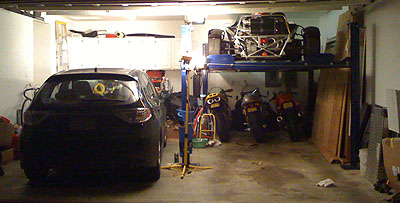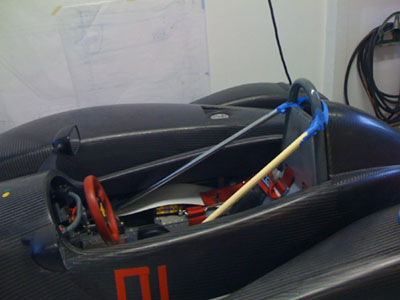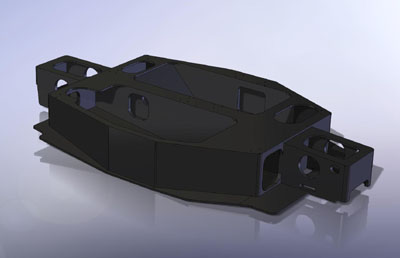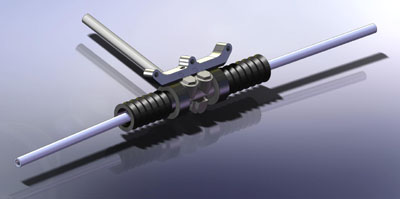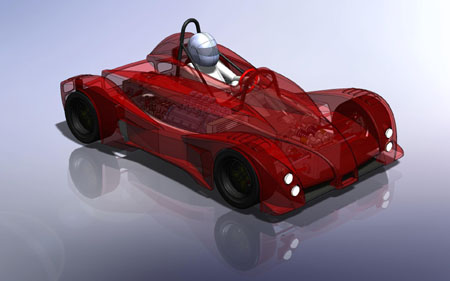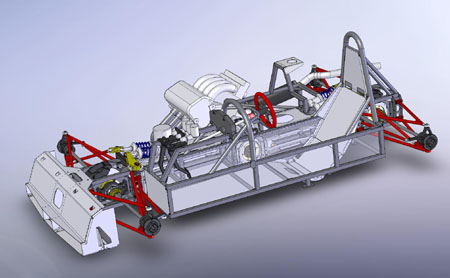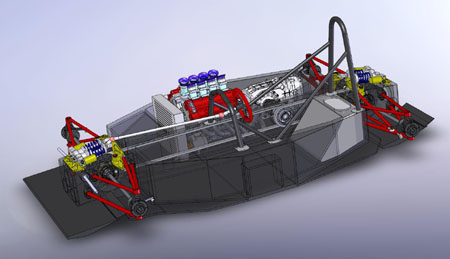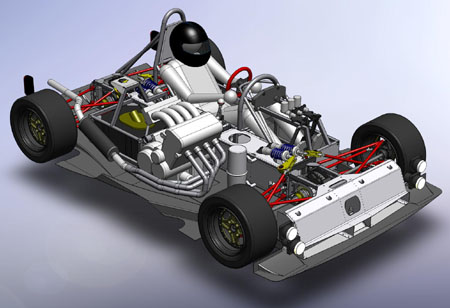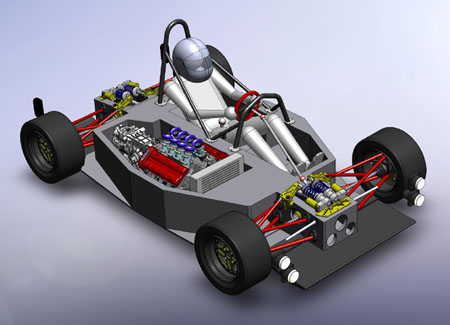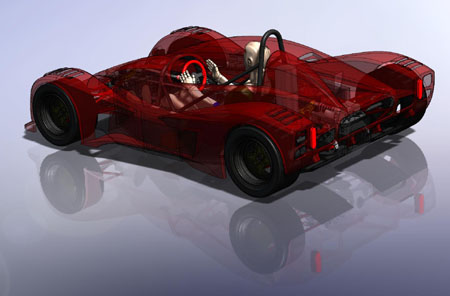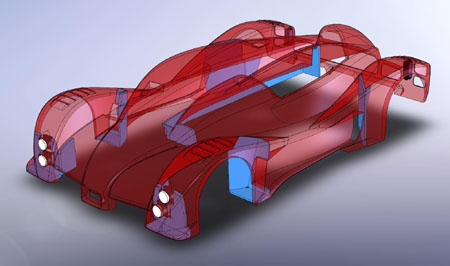|
02/17/08 I periodically get e-mails about various projects that have drawn inspiration, to various degrees, from the dp1 design and build efforts. It is always gratifying to see others making use of the learning curve and the discovery process I have been (and still am) going through. These range from kit builds to original designs to student class projects like the Preble ESR. Some are quite sophisticated. Last April I got such an email about a student project in England. Dr. Ian Scott wrote "The students involved are all excluded from main-stream education with behavioural problems etc, the project has given them an interest that I hope can be sustained to help them in the coming months and beyond.....". He provided a few pictures: Yesterday a follow-up email impressed me so much with what was achieved that I just had to post a writeup here.
Both the execution and the scope of the project are impressive. This is the only one that I'm aware of that actually follows through on the dp1 design goals of a lightweight AWD car. A number of FSAE teams have contacted me over the years, even before the dp1, to talk about the possibility but ultimately considered it too hard/risky and went with tried-and-true RWD layouts (in fact the dp1 project kickoff was the result of one such conversation, with me basically saying 'fine, I'll just do it myself'). While the result of this particular effort bears an obvious resemblance to the dp1, a close look reveals a great number of original solutions and shows that a good deal of thought went into both the ground-up design and the build. I did not provide any input besides what's on my site. This project is inspirational in its own right and hopefully will motivate more people contemplating doing their own builds to just go for it and not wait until some unknown future 'perfect' circumstance... Might even serve as a kick for me to make more progress on the production dp1 ;) I asked Ian for more details and rather than try to re-tell it in my own words I'm including his e-mail below: "Before going into teaching I was an engineer with a great interest in all forms of motorsport I finally settled on Hillclimbing and sprinting (Solo I believe in the states) at the time it was relatively inexpensive. Over the last thirty plus years I was primarily involved in building singleseaters for this discipline.(Megapins) I was lucky enough to become a close friend of Carrol Smith (a right place right time scenario) it was he that introduced me to FSAE in Detroit an event I have had the pleasure of attending as a Design judge for the last eight years. I have also had opportunity to attend the Australian event as Senior design judge with Allan Staniforth, (a couple of my builds are in Allan's books.) I have been lucky in the respect that my Education Authority have seen the value of using racecars as a teaching aid (most teens are interested in cars). Before starting the project I spent at least six months assessing the skills of the children in class, the three boys concerned have shown the most interest and practical apptitude for the project. The total time taken to complete the car from start to finish was only 4 school months (this also included easter holidays etc) such was the enthusiasm. Glenn Shields in the months leading up to the start became an accomplished welder in both mig and tig to the point of at the age of 14 years 7 months achieving a National post 16 qualification, a local engineering company having seen the quality of his work have already offered him a job when he leaves school (they are also going to fund any further education he may wish to undertake). Leon Cowx was interested in custom bodywork, MTV and pimp my ride are to blame for a lot of things....he was able to develop some good woodworking skills in the production of the plug he the developed into an accomplished mould maker /laminater/and spray painter. He has been accepted into the army where he will train as an engineer provided he shows good attendance at school for his remaining 4 months. The final student, Dan Matthews, was the most technically minded of the three from day 1 he showed confidence in lathe and milling machine work. He started off slowly by producing threaded bushes etc for wishbones and moving on to high spec production as in centre lock hubs complete with machined alloy nuts. He also was able to work to small enough tolerances to make the steering rack of which he produced a number with varying pinion sizes to enable us to develop a good steering ratio to lighten up the steering etc. The front hubs were steel fabricated by Glenn but all the pressed bearing housings were made by Dan and since the moment we first applied torque to the driveshaft nuts nothing has come adrift. He is also responsible for manufacturing the rear diff housing combining it with single brake disk and caliper mount. As yet Dan's future is not certain but he has been accepted back into main stream education for six months to try and obtain some academic qualifications. At present he is looking to be our most successful student (you must bear in mind ordinary schools have found their disruptive behaviour, bad language and disaffection impossible to handle). The project has been a remarkable achievement by any standard you choose. I am really impressed by the change in their attitudes and inclinations. As I said previously the car has been fully tested and shows exceptional promise. The four wheel drive aspect offers a remarkable amount of confidence in power application compared to my 30 years of experience with conventional rear wheel drive formula type cars. I still have to find its limit, I am sure I will in the heat of competition because as you know one doesn't really give everything in testing.
03/08/08 The consequences of my disaster last June are finally being taken care of, which means the bikes had to leave the livingroom for a bit. Easier said than done... But, now the dp1 prototype along with the molds and the plug are in their new home (I did say things were happening, right? ;) and the garage looks a bit different.
With the Atom up on the lift I took the opportunity to work on some oil leaks because it tends to drip on the Mini and the bikes. Turns out one of the drysump scavenge fittings was cracked so I had it re-welded and then put it back in. Helps that M has small hands that can get into tight spaces better than mine and that she's willing to use them on cars. We'll see if it still leaks. I'm glad John has redesigned the drysump plumbing for the dp1 and all future installs... But now back to the dp1. I'm now on the sixth full revision of the composite chassis and like this one a lot. It's getting close. Should be ready in the flesh in about three months, give or take. As part of this redesign I've been experimenting with different rollbar configurations. The one pictured below makes a lot of sense engineering-wise but I was concerned about the actual feasibility of getting in and out of the car. So I mocked it up and tried it first-hand.
Works fine. A bit more exercise on entry and exit, but once in there's plenty of elbow room and after the forward braces are padded they will serve as good props to rest the helmet on in 2g+ turns. So it's a go, at least for the moment. Now on to the rest of it. Sharp eyes will notice a few more changes in the CAD picture above. Yes, work continues. Lots of it. The latest set of revisions will make this thing a lot easier to manufacture, and lighter too. I like this process of evolution. Live, learn, improve. 03/16/08 I've been making some good progress on the production design so it's time for another update. Pretty much every part in the car is completely new, the bodyshell is the only thing I haven't changed so far (but it will be tweaked also when the time comes). The composite chassis is coming along although a lot of details still need to be resolved. It should weigh about 50-60 lbs, probably 85 lbs with the brackets and rollbar attached. That's roughly 50 lb less than the complete prototype chassis (including aluminum panels) and should be several times stiffer, too. Learning from some lessons and feedback on the prototype the cockpit is now much larger, with 19.5" of hip room (same as my office chair) and accommodating drivers of up to about 6'3"
The work is iterative and most parts end up getting completely redesigned several times before a reasonable approach is found. Here's the steering rack mount as an example. It started out as a sheetmetal bracket:
The bracket itself is the result of at least three completely different iterations. SolidWorks says it should weigh 1.6 lbs but I wasn't happy with how flexy it would be. Then I tried installing it in the redesigned chassis and quickly realized that I wouldn't have access to the mounting holes. The bracket also interferes with the chassis in a couple spots. So, I redesigned it in aluminum.
The weight came down to 1.0 lbs and FEA shows stiffness increased quite a bit. With a 300 lb tie rod load at 10 degrees off-axis and at the limit of rack travel the ball socket only moves 0.003". OK, this doesn't account for any flex in the rack itself but basically the mount is pretty good. Time to move on to the shock mount plate... And it interferes with the rack mount. Ugh. So another completely different design, this time bolting to the shock plate rather than the chassis itself.
It is now a much simpler, more manufacturable part and only weighs 0.5 lbs. That's more like it! The whole process took about 6 hours including multiple FEA simulations. Did I mention CAD rocks?! With all the changes going on, I can't resist the temptation to post a couple udated pictures of the entire design. Click on each for a larger version (1920x1200). 03/20/08 While working on some new stuff I had to load in the prototype model to check a couple dimensions and was reminded of just how much difference there is between prototype and production designs. The pictures below illustrate:
Despite being a V8 with twice the horsepower, the production car is 100 lbs lighter and several times stiffer. A lot safer too. One of the many lessons I've learned from the prototype is design for serviceability and that is being given a very high priority. The more I work on the new design the more I like it. Lots of people have asked me why I don't just try selling the car in its prototype form and my answer was that knowing all the things that aren't quite right I wouldn't buy one myself. But the production car? - Hell yeah! On a different subject, someone recently gave me a model of 95th percentile male human (made with BodyWorks) so I couldn't resist making yet another wallpaper - click for full size. And yes, the virtual big guy fits, all 6'2" and 200 lbs of him. 03/22/08 As I mentioned I'll be tweaking the bodyshell. Well, that's not entirely accurate because what I'm doing is adding to it. The additions consist of some internal panels, which will serve a multitude of functions at once. They stiffen the shell, interface (and seal, in places) the shell to the chassis, mount the headlights, serve as fender liners and also participate in internal and underbody airflow management.
A number of materials can be used but I have a particular one in mind - we'll see what the cost is both in money and weight. The panels have to be CNC cut (laser or router, depending on final material choice) and will be glued in place. |









